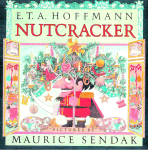Another Nutcracker season is well underway.
Costumes and sets have been prepped and painted, and audiences are waiting to delight in their favorite holiday dance performance.
Before you head to the theater this year, add another element to your “Nutcracker” experience: E.T.A. Hoffmann’s narrative tale.


Crown Publishers (a division of Random House Inc.) has re-released a stunning hardcover version of Hoffmann’s “Nutcracker”, with translation by Ralph Manheim and illustrations by the late Maurice Sendak.
Whether your first journey or your fifth visit, Hoffmann’s story and Sendak’s drawings are a perfect prelude to the beloved Christmas ballet.
As one might expect with two different media, some characteristics are shared and others divergent, though both the book and the ballet tell an equally enchanting story.
One major difference between them is the timeline. Although there are numerous iterations out there, most choreographic versions tend to portray the events as occurring in a single evening, whereas Hoffmann’s “Nutcracker” unfolds over many days, maybe even an entire week. Nonetheless, both open with the typical Christmas Eve celebration, though ‘the party scene’ is quite short in the book and very long onstage – taking up an entire Act of close to an hour.
Marie is Hoffmann’s heroine (which some choreographers still retain), and she is joined by the expected cast of characters: Dr. & Mrs. Stahlbaum, Drosselmeyer, and Fritz (who has a more expanded role in the book). During the party scene, Hoffmann’s description of the toys and Christmas presents equates to the magical life-size dolls that appear in the ballet, both suggesting a porous border between the real and the imaginary: a beautiful set-up for the introduction of the Nutcracker and his transformation into the Prince.
Like many fairy-tales, the book does tend to be a bit more gruesome (not too much, mind you) and superstitious than expected.
The fight scene – or scenes, as they are multiple nights of battle in Hoffmann’s version – is one such moment. The Mouse King is described as a horrific, seven-headed creature; his grisly, spooky, tormenting nature captured perfectly by Sendak’s accompanying illustrations. At the conclusion of the first battle, Marie cuts her arm on a glass cabinet, badly enough that she is relegated to her room to recover. It is here that she is told ‘The Story of the Hard Nut’ by Drosselmeyer and begins to learn how the Nutcracker came to exist.
This part of the story is often left out of the ballet, probably due to its length (nearly the whole middle third of the book). But it was delightful to hear this part of the narrative and understand both the connection and the history of the Nutcracker/Prince character.
Following the final battle between the mice and the Nutcracker where the latter is of course victorious, Hoffmann sends his two main characters on a celebratory journey to the ‘Land of the Dolls’ and ‘The Capital’. Their final destination is of course similar to the ballet, though they seem to avoid the snowy forest on their way there.
Whether your preference lies with the written word or live action, Crown Publishers’ release of E.T.A. Hoffmann’s “Nutcracker” is a must-have addition to your home library. And, it would make a wonderful holiday gift for any budding ballerina or dance lover on your list.

Heather Desaulniers is a freelance writer, critic and dance historian based in Oakland, CA. She is the SF/Bay Area columnist for criticaldance.com, a contributor to In Dance, and the dance curator for sfarts.org. Dr. Desaulniers is currently researching the work of American modern dance choreographer, Sophie Maslow. Visit her blog at www.heatherdance.com.

Dance Advantage welcomes guest posts from other dance teachers, students, parents, professionals, or those knowledgeable in related fields. If you are interested in having your article published at Dance Advantage, please see the following info on submitting a guest post. Read posts from guest contributors.

